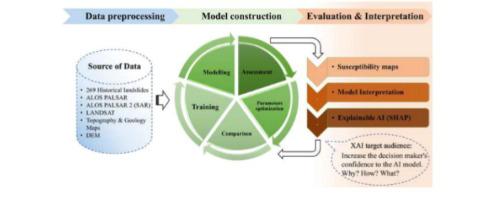Gondwana Research ( IF 6.1 ) Pub Date : 2022-08-19 , DOI: 10.1016/j.gr.2022.08.004 Husam A.H. Al-Najjar , Biswajeet Pradhan , Ghassan Beydoun , Raju Sarkar , Hyuck-Jin Park , Adbullah Alamri

|
As artificial intelligence (AI) techniques are becoming more popular in landslide modeling, it is important to understand how decisions are made. Fairness, and transparency becomes ever more vital due to ethical concerns and trust. Despite the popularity of machine learning (ML) algorithms in landslide modeling, the explainability of these methods are often considered as black box. This paper aims to propose an explainable artificial intelligence (XAI) for landslide prediction using synthetic-aperture radar (SAR) time-series data, NDVI (normalized difference vegetation index) time-series data and other geo-environmental factors such as DEM (digital elevation model) derivatives. We employed a Shapley Additive Explanations (SHAP) approach to understand how and what decisions ML-based models are making. 37 features were extracted from various sources such as ALOS-PALSAR (ALOS Phased Array type L-band Synthetic Aperture Radar), ALOS-2 (SAR), Landsat-8, topographic maps, and DEM for landslide susceptibility mapping in a landslide prone area in Chukha, Bhutan as a test site. The result was then compared using two standard ML methods: random forest (RF) and support vector machine (SVM). As per results, the RF model outperformed (0.914) the SVM. Moreover, the higher reliability of the RF model was proved by the area under the curve (AUC) of 0.941. XAI results revealed, features like altitude, aspect, NDVI-2014, NDVI-2017, and NDVI-2018 were the most effective features for landslide prediction by both models. Interestingly, among those features, NDVI-2014, aspect, and NDVI-2017 negatively correlated with the landslide prediction; whereas positively correlated when SVM was utilized. This interpretation ability indicates the advantages of XAI over the conventional methods as it measures the impact, interaction and correlation of conditioning factors within a model. The current research finding can provide more transparency and explainability when working with MLs in landslide studies. This could help to build trust among the geoscientists and decision-makers while making geohazard prediction.
中文翻译:

一种使用基于可解释人工智能 (XAI) 的 Shapley 附加解释的新方法,用于使用时间序列 SAR 数据集进行空间滑坡预测
随着人工智能 (AI) 技术在滑坡建模中变得越来越流行,了解如何做出决策非常重要。由于道德问题和信任,公平和透明度变得越来越重要。尽管机器学习 (ML) 算法在滑坡建模中很受欢迎,但这些方法的可解释性通常被认为是黑匣子。本文旨在利用合成孔径雷达 (SAR) 时间序列数据、NDVI(归一化植被指数)时间序列数据和其他地理环境因素(如 DEM(数字高程模型)导数。我们采用 Shapley Additive Explanations (SHAP) 方法来了解基于 ML 的模型如何以及做出哪些决策。从各种来源中提取了 37 个特征,例如 ALOS-PALSAR(ALOS 相控阵型 L 波段合成孔径雷达)、ALOS-2 (SAR)、Landsat-8、地形图和 DEM,用于在滑坡易发地区进行滑坡敏感性绘图在不丹楚哈作为试验场。然后使用两种标准 ML 方法比较结果:随机森林 (RF) 和支持向量机 (SVM)。根据结果,RF 模型的性能优于 (0.914) SVM。此外,0.941 的曲线下面积 (AUC) 证明了 RF 模型的更高可靠性。XAI 结果显示,海拔、坡向、NDVI-2014、NDVI-2017 和 NDVI-2018 等特征是两种模型预测滑坡的最有效特征。有趣的是,在这些特征中,NDVI-2014、坡向和 NDVI-2017 与滑坡预测呈负相关;而在使用 SVM 时呈正相关。这种解释能力表明 XAI 优于传统方法,因为它测量模型内条件因素的影响、相互作用和相关性。在滑坡研究中使用 ML 时,当前的研究结果可以提供更高的透明度和可解释性。这有助于在地质学家和决策者之间建立信任,同时进行地质灾害预测。


























 京公网安备 11010802027423号
京公网安备 11010802027423号